Research domains | Supramolecular Chemistry | Molecular Modeling | Living Radical Polymerization | Bioacoustic | Scientific Achievements
| Visitors number: |
| Recently the photo-isomerization capacity of the azobenzene groups was further explored from the point of view of the synthesis of "intelligent" materials capable of responding to external stimuli (in our particular case visible light). Studies developed in collaboration with North Paris University, in France, and the Centre of molecular and macromolecular studies of the Polish Academy of Science made possible the synthesis of hetero-organic azo-polymers with potential applications in biology, photonics or for energy storage. It is well known that azo-materials have the unique capacity to generate nano-surfaces with a controllable profile due to the contraction of the material under UV radiation. Therefore transparent and opaque domains are created as could be seen in the Figure below: |
|
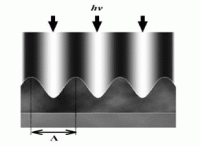 |
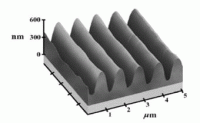 |
| Our unique idea implies the use of a polysiloxane backbone that conferred to the material special properties such as high flexibility of the backbone, low glass transitions, biocompatibility and thermal stability. To these azobenzene units, nucleobase (adenine, thymine, cytosine, and uracyl), donor/acceptor systems and quaternary ammonium salts were attached in order to enlarge the range of properties and applications of these designer materials. | |
Non-covalent 3D networks: |
|
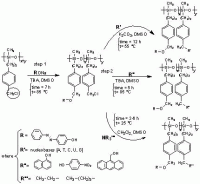 |
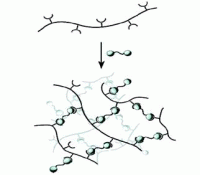 |
Nano-structurated Azo-polysiloxanes films nanostructurate: |
|
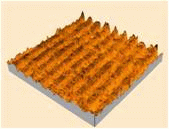 |
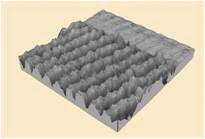 |
Photosensitive Micelles: |
|
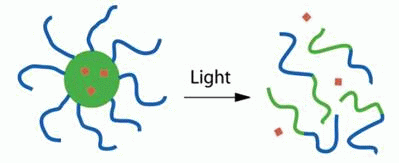 |
|
Nano-structured surfaces generated using azopolysiloxanes present great interest due to their potential applicability in photonics (increased light yield by elimination of the diffusion processes, increased yield of solar energy conversion), biology (unidirectional growth of cell cultures, orthopaedics) and in nano-lithography. In collaboration with the National Institute of Physic for Laser, Plasma and Radiation (Dr. I.Apostol and V.Damian) 250 nm up to 1000 nm width nanostructured surfaces were already obtained under 190 or 360 nm UV irradiation. |
|
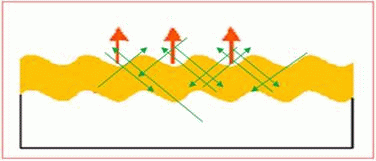 |
|
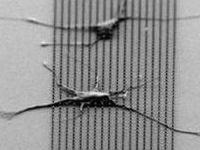 |
 |
H.G. Craighead , C.D. James, A.M.P. Turner - Current Opinion in Solid State and Materials Science 5 (2001) 177-184; M. Yoshinari, K. Matsuzaka, T. Inoue, Y. Oda, M. Shimono -Journal of Biomedical Materials Research Part A, (2004) 68 A, Issue 2, 227-234 |
|
Our group has great interest in the study of laser immobilization and manipulation of biomolecules on the surface of azopolysiloxane films. In this direction our group made a remarkable theoretical contribution with regards to understanding the mechanisms of fluidization under laser irradiation by introducing the concept of "conformational instability", that can explain the flowing processes observed at room temperature for materials with glass transitions between 80-100 °C. (N. Hurduc, R. Enea, D. Scutaru, L. Sacarescu, B. C. Donose, A. V. Nguyen - Nucleobases modified azo-polysiloxanes, materials with potential application in biomolecules nanomanipulation - Journal of Polymer Science Part A: Polymer Chemistry 2007, 45( 18), 4240-4248). Tests regarding immobilization of DNA on the surface of nano-structured polysiloxanes films have been performed in collaboration with the School of Engineering at the University of Queensland, Australia (Prof. Anh V Nguyen, Dr. E. Taran, Dr. Bogdan Donose) and the Biochemistry Institute in Bucharest (Dr. N. Nichita). It has been shown that conformational instability could be created under specific technical conditions even in the absence of a polarized UV laser source. Studies regarding the synthesis and the determination of the critical micellar concentration (CMC) have also been performed for amphyphilic azopolysiloxanes. Experimental results showed that a CMC of 10-3 to 10-2 g/L is characteristic for polymers containing up to 40-50% quaternary ammonium groups. A red shift was observed in the UV spectra suggesting a type J aggregation of the azobenzene groups. |
|
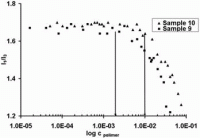 |
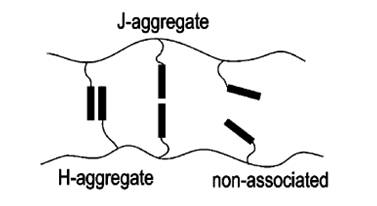 |
71 Mangeron Bd., 700050-Iassy, Romania, Phone: 0232 278680, Fax: 0232 271311, http://www.ch.tuiasi.ro
Razvan


